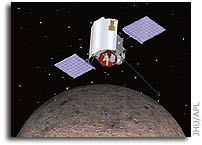MESSENGER Mission Passes Five-Year Mark

It’s been five years since MESSENGER was launched atop a Delta II rocket on August 3, 2004, and they have been busy years. It has been a long journey, says MESSENGER Mission Operations Manager Andy Calloway, “not just in distance travelled – just over 3.5 billion miles so far – but also in terms of significant milestones and accomplishments.”
MESSENGER has executed five planetary flybys – one of Earth on August 2, 2005; two of Venus, on October 24, 2006, and June 5, 2007; and two of Mercury, on January 14, 2008, and October 6, 2008. “These were not merely gravity assists, but also major science data collection endeavors that required months of detailed planning,” says Calloway of the Johns Hopkins University Applied Physics Laboratory (APL).
The probe has completed four major deep-space maneuvers (DSMs) and 12 trajectory-correction maneuvers, and mission controllers have been able to forgo six additional planned course corrections by using MESSENGER’s solar panels creatively, harnessing solar radiation pressure to adjust the spacecraft’s trajectory.
“Because of the implementation of solar sailing, the MESSENGER team has not used propellant to correct the cruise trajectory of the spacecraft since December 19, 2007, in advance of the first Mercury flyby,” says MESSENGER Mission Systems Engineer Eric Finnegan, of APL. He credits a solar sailing team of engineers – Ken Williams in navigation, Jim McAdams in trajectory design, and Dan O’Shaughnessy in guidance and control – “for increasing mission performance while lowering mission risk by making this technique operational.”
Over the years, MESSENGER’s circuitous journey has presented opportunities within challenges. “We’ve been through periodic extended communication outages as the spacecraft travels on the far side of the Sun from Earth during superior solar conjunctions and frequent close passages by the Sun during perihelion crossings,” Calloway says. “But MESSENGER has traveled as close to the Sun as only three tenths of the Earth-Sun distance during these crossings, providing valuable information and experience in preparation for orbital operations, which begin following the critical Mercury orbit insertion maneuver in 2011.”
In addition to nine major instrument software loads during these five years (with two more planned this month), the third main processor flight software update of the mission was successfully completed on July 14, 2009.
“This new software significantly increases the spacecraft’s capabilities for the upcoming orbital phase,” Calloway says. “These processor loads require months of testing, and then once the software is loaded to the spacecraft, the processor has to be rebooted for it to take effect. This rebooting results in a transition to a Sun-safe rotisserie mode in which the spacecraft transmits a beacon signal as it rotates slowly every 3.5 hours. Operators in the control center monitored the signal as it briefly swept through the ground station’s field of view one rotation after the reboot, and seven hours later they sent a command with precise timing to halt the rotation and begin restoring the spacecraft to its nominal operational mode.”
More than 90% of Mercury’s surface has now been imaged after MESSENGER’s flybys, including territory never seen before by spacecraft, and planning is in full swing for the orbital phase of the mission. Up next is a third pass by Mercury on September 29, 2009, a fifth DSM on November 24, 2009, and then on March 18, 2011, MESSENGER will become the first spacecraft to enter into orbit around the innermost planet.
“When MESSENGER launched five years ago, even our first encounter with Mercury seemed far off,” recounts MESSENGER Principal Investigator Sean Solomon, of the Carnegie Institution of Washington. “Our first two Mercury flybys last year produced an explosion of new and exciting observations, and our cruise through the inner Solar System as of this important anniversary is more than 75% complete. The entire MESSENGER team is eagerly awaiting the first observations of Mercury from orbit.”
MESSENGER (MErcury Surface, Space ENvironment, GEochemistry, and Ranging) is a NASA-sponsored scientific investigation of the planet Mercury and the first space mission designed to orbit the planet closest to the Sun. The MESSENGER spacecraft launched on August 3, 2004, and after flybys of Earth, Venus, and Mercury will start a yearlong study of its target planet in March 2011. Dr. Sean C. Solomon, of the Carnegie Institution of Washington, leads the mission as Principal Investigator. The Johns Hopkins University Applied Physics Laboratory built and operates the MESSENGER spacecraft and manages this Discovery-class mission for NASA.









